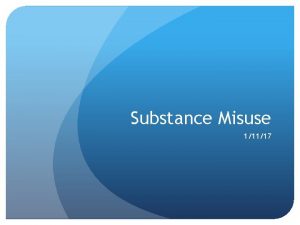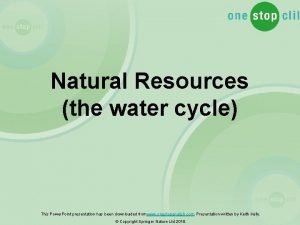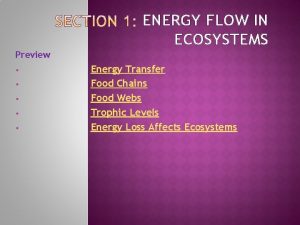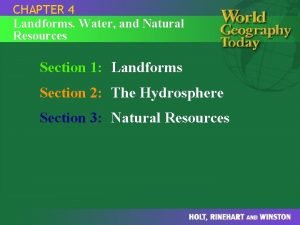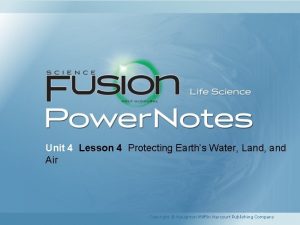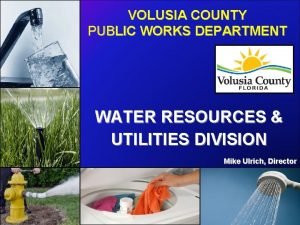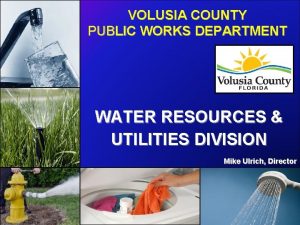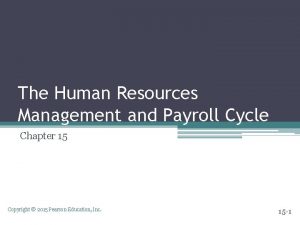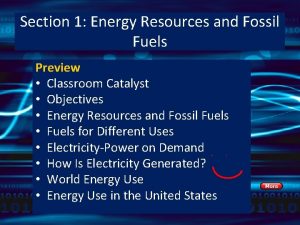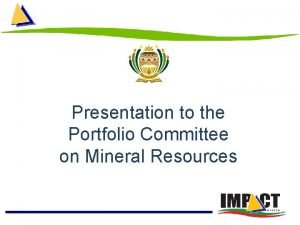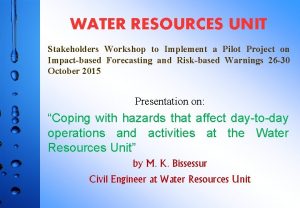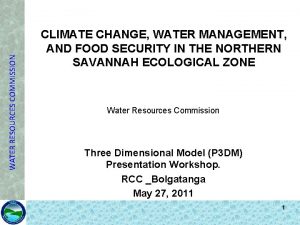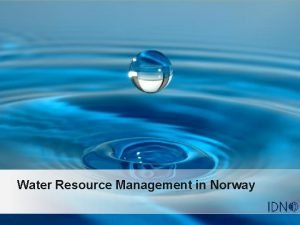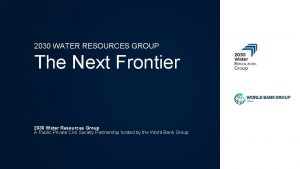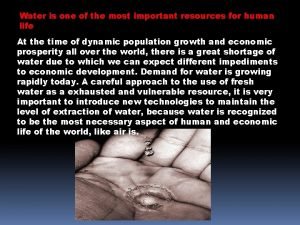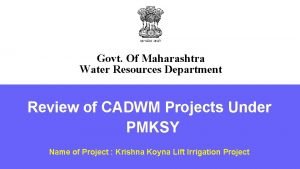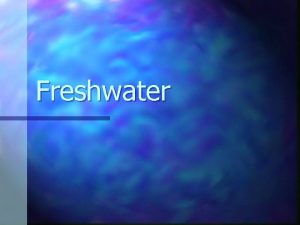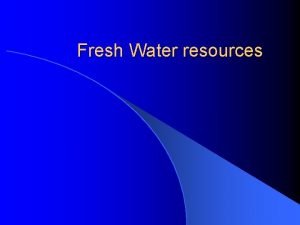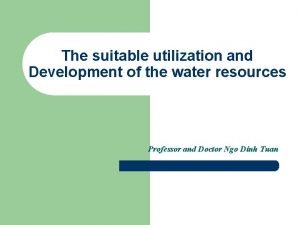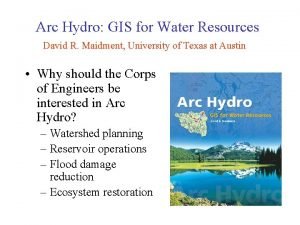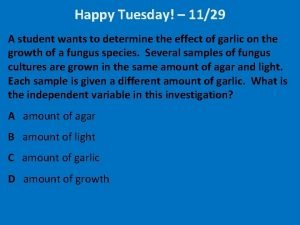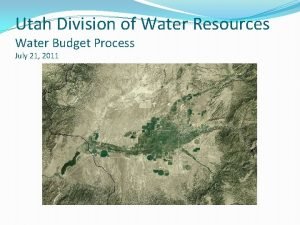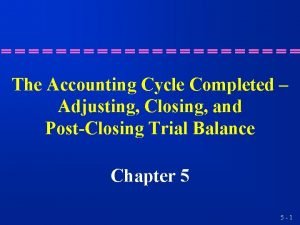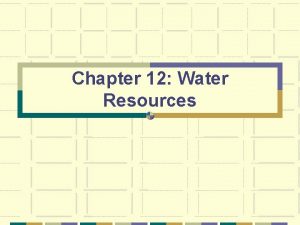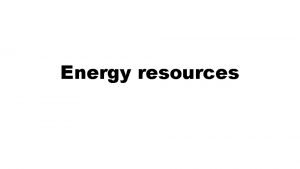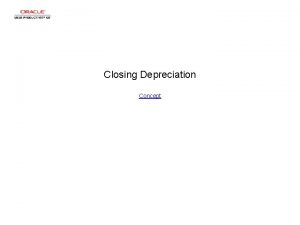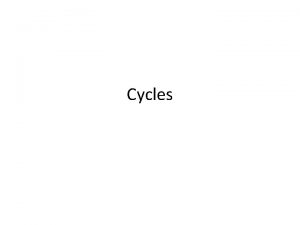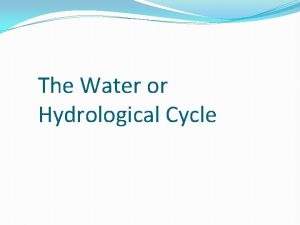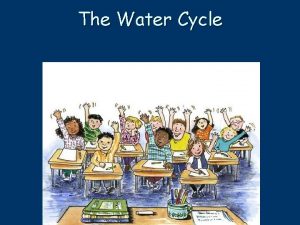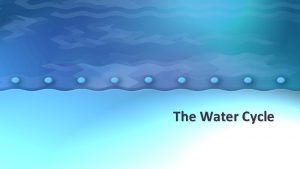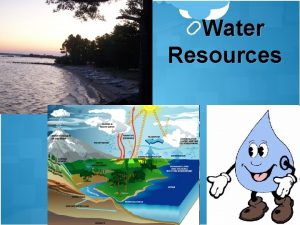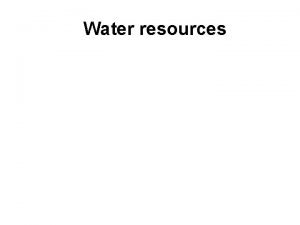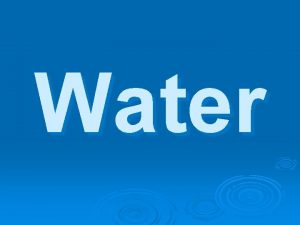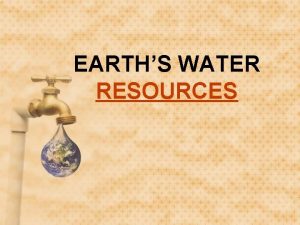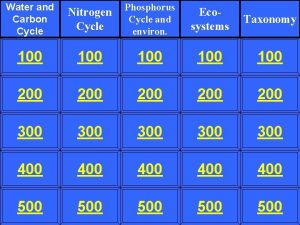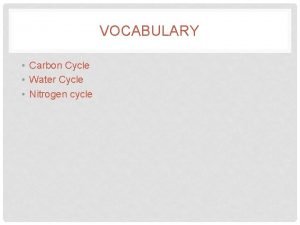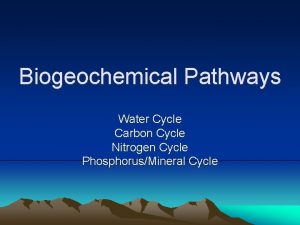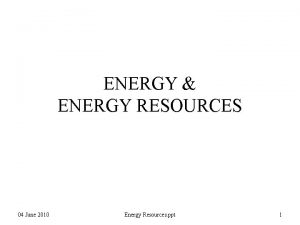CLOSING THE WATER CYCLE RECOVERING ENERGY AND RESOURCES




















































- Slides: 52

CLOSING THE WATER CYCLE, RECOVERING ENERGY AND RESOURCES IN THE CITIES OF THE FUTURE Vladimir Novotny Partner Aqua. Nova LLC, Gloucester, MA Professor Emeritus Marquette University, Milwaukee, WI Northeastern University, Boston, MA 2012 Kappe Lecture American Academy of Environmental Engineers and Scientists

Cities of the Future – Utopia or Unavoidable Reality “Urbanites now outnumber their rural cousins – and that’s surprisingly good news for the environment” “The average New Yorker uses far less water and produces less than 50 per cent of the green-house emissions of the average US citizen” Barley 2010, New Scientist 2785, 32 -37 Model of Tianjin Ecocity, China COF – an international movement towards urban water, energy and resources sustainability However, there is an urgent need for this and future generations to change the paradigm of how water, energy and resources are managed in urban areas.

Under Current (4 th) Paradigm Urban sustainability is compromised by Population increases and migration Current and future effects of climatic change Increasing imperviousness of watersheds, more polluted runoff Excessive use of energy Unbalanced hydrology by groundwater infiltration into sewers Excessive use of water Competing uses of resources

Urban Metabolism A Linear needs to be changed to B Cyclic or Hybrid

�Current urban systems are mostly linear �Excessive water volumes are withdrawn from mostly distant surface and groundwater sources � Inside the community water is used only once and wastefully � Drinking water used in landscape irrigation for growing grass � Only about 5 % of treated potable water is used for drinking and cooking � Great losses of water by leaks and evapotranspiration �Water is transferred underground to distant large wastewater treatment plants � The WWTPs use excessively energy, emit carbon dioxide and often methane which are green house gases � The WWTPs remove but rarely recover nutrients for reuse � Effluent dominated receiving water bodies after discharge � Water short water bodies in the cities Courtesy Philadelphia Water Department � Reduced or no base flow. � Streams converted to (combined) sewers or concrete lined channels with no natural low flow.

Cities must adapt to the impact of global climatic change Heat-temperature and global climatic changes Urban heat islands Disaster risks in urban areas are already severe and will be more deadly if nothing is done Drought Flooding More frequent and intense catastrophic rainstorms (20 – 50 cm rainfalls) and tidal surges Expected sea level increase (Venice, New Orleans, Tampa, Galveston, The Netherlands, Bangladesh) Inadequate subsurface urban drainage infrastructure Large parts of some cities are or will become inhabitable (Mumbai, Bangkok, New Orleans) From IPCC 2011 report Credit Chicago Tribune and USA Today

Macroscale (Giant) Footprints of Sustainability A “footprint” is a quantitative measure showing the appropriation of natural resources by human beings Ecological - a measure of the use of bioproductive space (e. g. , hectares (acres) of productive land needed to support life in the cities, including assimilation of pollution) Water - measures the total water use on site and also virtual water (usually expressed per capita) Carbon - is a measure of the impact that human activities have on the environment in terms of the

Ecological footprint World Population Available productive land Ha/person Ac/person 1995 < 6 billion 1. 5 3. 6 2040 >9 billion <1 2 Current ecological footprint Countries with 1 ha/person or less Most cities in undeveloped countries Countries with 2 -3 ha/person Japan and Republic of Korea (democratic) Countries with 3 -4 ha/person Austria, Belgium, United Kingdom, Denmark, France, Germany, Netherlands, Switzerland Countries with 4 -5 ha/person Australia, Canada and USA Imbalance Year If the cities in the currently rapidly developing countries (China, India, Brazil) try to reach the same resource use as that in developed countries, conflicts may ensue

Urban water use in some countries VIRTUAL WATER l/cap-day Food 1928 Electricity 53 -73 liter/kg 15, 500 900 1, 000 Beef Corn Milk In. Difference Nairobi (Kenya) and between total other megalopoli of the on site and developing world urban domestic uses water use is < 501 gallon=3. 78 liters liter/capita-day 1 kg = 2. 2 lbs

One Month Supply of Water for Typical Florida Family 45 m 3 (12, 000 gallon) tank Weight = 45 tons Cost of water is about $40 -70/month 2/3 of cost is to transport the water Major use of expensive energy (1 -2 k. Watt/m 3) Much of this potable water is used for landscape irrigation Picture credit Professor James Heaney, University of Florida

GHG (carbon) Emission by Cities Top ten countries in the CO 2 emissions in tons/person-year in 20081 Qatar Kuwait UAE Aruba Bahrain Luxembourg Australia USA Saudi Arabia Canada 49 30. 1 25 21. 7 21. 4 21. 5 18. 6 18. 8 16. 6 16. 3 Selected world cities total emissions of CO 2 equivalent in tons/person-year 2 Washington DC Glasgow UK Toronto CA Shanghai, China New York City Beijing China London UK Tokyo Japan Seoul Korea Barcelona Spain 19. 7 8. 4 8. 2 8. 1 7. 1 6. 9 6. 2 4. 8 3. 4 Selected US cities domestic emissions of CO 2 equivalent in tons/person-year 3 San Diego CA San Francisco Boston MA Portland OR Chicago IL Tampa FL Atlanta GA Tulsa OK Austin TX Memphis TN 7. 2 4. 5 8. 7 8. 9 9. 3 10. 4 9. 9 12. 6 11. 06 1 World Bank (2012); 2 Dodman (2009) ; 3 Gleaser and Kahn (2008) 2, 3 Values include transportation (private and public), heating, and electricity GHG = Green House Gases (CO 2, methane, nitrogen oxides and other gases)

Total energy footprint of cities Population density matters LID potential Ecocities 6 cities Qingdao

The Fifth Paradigm GOAL: WATER CENTRIC SUSTAINABLE AND RESILIENT COMMUNITIES Three E’s of Sustainability 1. ECONOMY 2. ECOLOGY 3. EQUITY Create jobs, income and tax base Protect, restore and build city’ s natural assets and eliminate pollution All residents have an access to economic opportunities and are not exposed to environmental harms J. Fitzgerald – Emerald Cities

Vision of the Cities of the Future The 5 th (Sustainable) Paradigm Definition/Vision An ecocity is a city orofa an part. Ecocity: thereof that balances social, economic and environmental factors (triple bottom line) to achieve sustainable development. A sustainable city or ecocity is a city designed with consideration of environmental impact, inhabited by people dedicated to minimization of required inputs of energy, water and food, and waste output of heat, air pollution - CO 2, methane, and water pollution. Ideally, a sustainable city powers itself with renewable sources of energy, creates the smallest possible ecological footprint, and produces the lowest quantity of pollution possible. It also uses land efficiently; composts used materials, recycles or converts waste-to-energy. If such practices are adapted, overall contribution of the city to climate change will be none or minimal below the resiliency threshold. Urban (green) infrastructure, resilient and hydrologically and ecologically functioning landscape, and water resources will constitute one system. Adapted from R. Register UC-Berkeley Currently 200 Chinese urban developments claim to be ecocity (USA Today)

q Reduce, Reclaim, Reuse and Restore - 4 Rs 1. 2. 3. 4. Reduce - Water and energy conservation Reclaim 1. Treat for safe discharge into environment – TMDL 2. Reclaim energy (heat), nutrients Reuse after additional treatment 4 th R – Restore water bodies as a resource q Separate, Sequester and Store- 3 Ss 1. 2. 3. Separate Blue, White, Gray, Yellow, and Black Water Sequester GHGs and remove/detoxify toxics Store reclaimed water on the surface and/or underground q Toilet to Tap – 2 Ts (is it needed? ) o Reclamation with or without 3 S for potable reuse 4 Rs, 3 Ss and 2 Ts Closing the Cycle

COF Criteria Based on World Wildlife Fund’ One Planet Living WATER – Reduce water demand by 50% from the national (state) average Water conservation (more efficient water fixtures), xeriscape) Using additional sources (stormwater, desalination) SOLID WASTE – No solid waste to landfill Reclamation and reuse ENERGY – Carbon neutrality Minimization or elimination use of fossil fuels Renewable energy sources Passive energy savings (Energy STAR) Water conservation (reduction of pumping energy, CO 2 emissions Energy and resource recovery from water, used water and solids SUSTAINABLE TRANSPORTATION

Nested semi-autonomous Buildings Resilient water Neighborhoods centric sustainable Cities ecocity Energy efficient, water saving Surface drainage Water reuse (irrigation, toilets, etc. ) Resource recovery Water Energy Nutrients Source Steve Moddemeyer

Renewable Energy Passive energy sources 1. 4. MW Voltaics array in Sonoma County Household voltaics Wind turbines in Dongtan

Xeriscape – use of native plants (or not thirsty grasses) With native plants there is almost no irrigation water use Aesthetically pleasing Flagstaff (AZ) landscape Prairie grass and native flower landscape

Urban Best Management Practices with LID Concepts are an Integral Part of the COFs Green Roofs Save energy and store water Rain gardens Infiltrate and treat runoff Porous pavement Courtesy City of Seattle Infiltrate, store and treat runoff Ponds and wetlands Store, treat and infiltrate runoff Courtesy of Aqua. Tex Sci. Consulting

Urban Water Body Restoration and Daylighting are Important Before Photos V. Novotny Courtesy Beijing Hydraulic Research Institute Courtesy CDM After Courtesy PUB Singapore After Lincoln Creek in Milwaukee Dayligthted Zhuan River in Beijing Kallong River in Singapore

Water centric (LID) drainage in ecocities’ 1 order streams Solar Panels Berlin, Landseberger Tor. Credit Jack Ahern, U. Mass Hammarby Sjöstad Credit Malena Karlsson Dockside Greens, Credit Aqua. Tex Sci. Consult. Zhiangjiawo, PRC. Credit Herbert Dreiseitl ,

Urban streams need base flow Water reclamation plants providing clean effluent for ecological flow does not have to be far from the city q q q o o o o Base flow can also be provided by Groundwater inflows Sump pumps in basements Upstreams Cooling water Condensate from AC Stored urban runoff in ponds Irrigation return flow None of the above should enter underground sanitary sewers Courtesy Aqua. Tex, Victoria, BC Dockside Greens Ecocity, Victoria, BC

If water is needed for local reuse, sewers can also be a source Package and small high efficiency treatment units can be installed to provide locally water for: • Ecological flow of restored streams • Toilet flushing • Landscape irrigation • Street flushing Idea: Concentrate used water for centralized resource recovery Adapted from Asano et al. (2007)

Double loop (black and gray) separation – Water Machine ATERR – Generic anaerobic treatment and energy recovery reactor PS – primary settler MF microfiltration UV ultraviolet osmosis NF nanofiltration ST storage RO reverse Heat recovery

Reclaimed water could be used In applications currently using high quality water supplies toilet flushing landscape and agricultural irrigation street and car washing pavement cooling to reduce heat island effect For protecting aquatic ecosystems by providing ecological base flows For recharging groundwater to enhance available water and/or preventing subsidence of historic buildings built on wood piles; As cooling water As a source of potable water in areas and times of Fit for Reuse

Distributed water management and resources recovery Restored stream To aquifer

y en e rg He at En. Ele c tri c En. Integrated Resource Recovery Facility = Water/Energy Machine Reclaimed non-potable Potable Water Quality A, B, C Urine Surface Water Brownwater Ground Water Grey water Rain Water Solid waste Energy Nutrients G, R, F X-S Hygienized Sludge Credit Kala Vairavamoorthy

q Characteristics of integrated resource recovery facility (IRRF) o More concentrated influent (COD > 1000 mg/L desirable) o Urine may be separated in clusters (contains 50% of P and >75% N) in 1% of flow – may be attractive in megalopoli of developing countries – Accra, Ghana) o Inflow and input contains sludge and other solids (shredded food and other organic solids). Other organic biodegradable solid waste may be trucked in (co-digestion) q Because of high COD, conventional aerobic (energy demanding) activated sludge treatment is not feasible and should be replaced by anaerobic processes o Conventional sludge digester requires large detention and high concentrations of solids and COD and need a lot of energy o Use Upflow Anaerobic Sludge Blanket (UASB) reactor

Energy from used water and sludge Heat recovered by heat pumps Pyrolysis Biogas from anaerobic processes Digester Upflow anaerobic sludge blanket reactor Types of gas Biogas 1 Household waste Composition 60% CH 4 33 % CO 2 1% N 2 0% O 2 6% H 2 O Energy content k. Wh/m 3 6. 1 Hydrogen fuel cell Microbial fuel cell Biogas 2 Agrifood industry 68% CH 4 26 % CO 2 1% N 2 0% O 2 5 % H 2 O 7. 5 Natural gas 97. 0% CH 4 2. 2% CO 2 0. 4% N 2 0. 4 % other 11. 3

Energy use in the urban water cycle California Water end consumers k. Wh/m 3 Water Supply, conveyance Germany k. Wh/cap. yr k. Wh/m 3 k. Wh/cap. yr 0. 00 -1. 06 00 -106 0. 121. 13 5 -50 Treatment 0. 03 -4. 23 3 -423 Distribution 0. 18 -0. 32 18 -32 1. 26 ~11 ~2000 ~21 0. 29 -1. 22 29 -122 Heat used by consumer in household for heating water for baths, kitchen, laundry Used water collection and treatment Total average energy use (without heating) 0. 390. 83 ~9502 32 -75 365 Meda et al. , Chapter 2 in Lazarova et al (2012) Water Energy Interactions in Water Reuse, IWA Publishing, London 2 Energy for water heating per capita/(municipal water consumption) 1

There is not enough energy in used water alone ENERGY POTENTIAL - Daily production per capita COD per capita unit load (including in-sink grinders) minus COD in the effluent (5%) Methane produced 0. 4 L/g of COD removed Methane energy 9. 2 W-hr/L of CH 4 110 g 105 g 43 L of CH 4 0. 4 k. W-hr TOTAL ENERGY POTENTIAL 146 k. W-hr/year TOTAL AVEGAGE ENERGY USE RELATED TO MUNICIPAL WATER USE (WITHOUT HEATING) 365 k. W-hr/capita-year

PERCENT OF TOTAL MSW 28. 5 13. 9 Total MSW 225 x 106 Tons/yr = 2 kg/cap-day 13. 4 6. 4 8. 4 12. 4 9. 0 4. 6 To: co-digestion, Include also manure, glycols & other biodegradable wastes To: pyrolysis or recycle 3. 4 To: recycle INTEGRATING SOLID WASTE INTO TOTAL RESOURCE RECOVERY US EPA : wwwepa. gov/osw/nonhaz/municipal/pubs/msw_2010_rev_factsheet. pdf

CODIGESTION Biogas Typical biodegradable solid (food and yard) recoverable Co-digestates waste production in the US Waste is about 0. 5 kg/cap-day that (PS and/or WAS) PS-Primary Sludge can be codigested with the WAS-Waste Activated Sludge Credit Dan Zitomer sludge Codigestates: Food waste, Solar and wind energy organic deicing fluids, yard waste, oil and hydraulic fluids, meat production waste, yeast, algae produced by CO 2 and can be implemented in IRRF and in clusters to provide more energy for heating the reactors and buildings and (in the future) to enhance fermentation and steam methane/carbon monoxide reforming to hydrogen

SYNGAS CO + H 2 BIO-OIL HEAT FOR PYROLYSIS HEAT FOR DRYING BIOCHAR HEAT RECOVERY TO CLEANING AND REFORMING COOLING PYROLYSIS GASIFICATION REACTOR DRYING GRINDING Yard vegetation waste Wood Construction lumber waste Agricultural waste solids Dried waste sludge PYROLYSIS CHAR SEPARATION CYCLONE DRY ORGANIC SOLIDS BIOMASS

Examples of new technologies Microbial fuel cell Converts organic biomass directly into electricity (from Rabaey and Verstraete, 2005) Bioelectrochemically Assisted Microbial Reactor (BEAMR) Converts organic biomass directly into hydrogen by adding small electricity to the reactor (from Liu, Grot and Logan, 2005) 95 % energy recovery from produced acetate

Upflow Anaerobic Sludge Blanket (UASB) Reactor BIOGAS CH 4 + CO 2 EFFLUENT EXCESS SOLIDS UASB Reactor BASED ON LETINGA • 0. 4 L CH 4/g COD removed • 9. 2 k. W-hr/m 3 of methane TWO STEP ANAEROBIC FLUIDIZED BED REACTOR WITH MEMBRANE Contains powdered activated carbon Kim et al. (2011) EST 45: 576 -581

It could be energy demanding Reverse osmosis Microfiltration, courtesy Siemens UV radiation

Hydrogen Fuel Cells Convert Biogas to Energy More Efficiently and Cleanly Than Combustion Installed in Glashusett in Hammarby Sjöstad Overall efficiency Hydrogen to electricity 65% With heat recovery 85%

Heat recovery from used water What is the heat or cooling energy equivalent of the energy extracted by the heat pump from a volume V =1 m 3 of used water with the temperature differential between incoming and leaving water ΔT = 12 o. C. Coefficient of performance of the heat pump varies between 2 – 5. The specific heat of water is Cp = 4. 2 J/(g o. C). Mass of 1 m 3 of water is ρ=1000 kg/m 3 = 106 g/m 3. Energy extracted from 1 m 3 of water is then Eac = V ρ ΔT Cp = 1[m 3] x 106 [g/m 3] x 12 [o. C] x 4. 2 [J/ g o. C] = 50. 4 x 106 J = 50. 4 MJ/(3. 6 MJ/k. W-hr) = 13. 95 k. W-hr If COP = 4 then the energy applied to extract the heat (cooling) from 1 m 3 corresponding to the 12 o. C temperature change will become Eap = Eac /COP = 13. 95 k. W-hr/4 = 3. 48 k. W-hr. And the net energy gain is ΔE = Eac - Eap = 13. 95 – 3. 48 = 10. 47 k. Whr/m 3

Struvite – Ammonium magnesium phosphate Upflow fluidized bed reactor Credit Kurita Industries Picture source James Barnard • Adding magnesium hydroxide increases p. H and precipitates ammonium and phosphorus as struvite • p. H can be adjusted by sequestering CO 2 produced in the treatment process or energy production

Growing algae fed by nutrients from used water and produced CO 2 yields more energy and bio-fuel and sequesters carbon Algal Farm – Source ENERGY RANT Biofuel can be used in diesel engines without modifications Micro-algae offers best prospects While crops yield 0. 5 to 1. 5 m 3/hayear, algae can yield 50 to 200 m 3/ha-year Algae sequester Source James Barnard, CO 2 lecture Clark’s

Developing Integrated Resource Recovery Facility - The Water Machine A. Energy from Concentrated Used Water B. C. D. E. recovered by anaerobic treatment Energy from Co-digestion of Sludge and Other High Concentration Liquid Organic Waste and Food Solids Energy from Pyrolysis of Organic Solids (waste wood, wood chips, cardboard, etc. ) Heat recovery from effluent and biogas conversion to energy Nutrient recovery

What is Possible 2020 - 2025 ? ? 2012 -2020

UASB R Input A CO 2 CH 4 Gas Storage BIOFUEL Engine Generator Thickener Input B Acid to adjust p. H Struvite DIGESTER Belt Filter Input C Pyrolysis Electricity CO 2 MF Mg. O DRYING CO+H 2 HEAT BIOFUEL CHAR UV EFFLUENT TO REUSE PS(Optional) CH 4+CO 2 TF Condensate Air METHANE/SYNGAS BASED IRRF

2050 or even before ? ? 2038

CO 2 H 2 BEAMR Input B CH 4 UASBR S-M-CO-R PS(Optional) UFBR Thickener Struvite Belt Filter Input C DRYING CO+H 2 Pyrolysis MF UV Mg. O TF HEAT BIOFUEL Condensate CHAR EFFLUENT TO REUSE Input A CO 2 for p. H adjustment and sequestering HEAT EXTREACTION H+ Air HYDROGEN BASED IRRF

ELECTRICITY PHOTOVOLTAIC SOLAR HEAT BIOGAS CO 2 H 2 or CH 4 SMR GAS STORAGE CH 4 H 2 Cell H+ $ $ FOR EXCESS ENERGY PRODUCTS DRYING SYNGAS ELECTRICITY HEAT PYROLYSIS BIOFUEL CHAR HEAT PUMP HEAT BEAMR UASB-R EFFLUENT ENERGY FLOW IN IRRF

Dockside Greens, BC (courtesy P. Lucey) Hammarby Sjöstad (courtesy Malena Karlsson) Concepts and technologies are available and “shovel” ready Masdar (UAE). Courtesy Foster and Associates Qingdao Ecoblocks, courtesy Prof. H. Fraker UC-B

Conclusions US has one of the highest per capita urban energy footprint Low density urban centers High automobile use Great reliance on fossil fuel (primarily coal) power production Adopting and adapting the ecocity guidelines are significantly increasing production from renewable carbon free sources Water conservation is effective Biogas conversion to electricity or hydrogen with carbon sequestering is effective Wind turbines on each block Large inclusion of solar power Limiting automobile use, hybrids and electric pug-ins are very effective Heat recovery from used water More efficient appliances and heating (e. g. , heat pumps) The goal of net zero carbon footprint is achievable by 2030 even in the US

Retrofit to the future Begin with satellite water/energy recovery cluster plants and implement efficiently on-site reuse Develop resilient and pleasing landscape drainage for clean water flows Combined sewers will become obsolete and current sewers oversized. Fit new plastic pipes into sewers and lease the excess space to phone, electricity and cable companies Implement solar and wind energy in clusters and in private homes – connect to smart energy grid Focus on development of efficient public transportation Convert existing regional WWTP into IRRF accepting both concentrated sewage and organic solids and sell the products and energy The existing capacity is far greater than that needed in the future for the same number of people

Acknowledgment: Jack Ahern, University of Massachusetts CDM – Smith (Paul Brown) CH 2 M-Hill (Glen Daigger, Masdar team) IWA COF Steering Committee Atelier Herbert Dreiseitl W. Patrick Lucey, Aqua. Tex Scientific Consulting PUB Singapore + many others http: //www. wiley. com/Wiley. CDA/Wiley. Title/product. Cd-0470476087. html http: //www. Aqua. Nova. LLC. com
 Water and water and water water
Water and water and water water Middlesbrough recovering together
Middlesbrough recovering together Natural resources water cycle
Natural resources water cycle What is transformation process
What is transformation process Example of fixed resources
Example of fixed resources Where can you find groundwater brainpop
Where can you find groundwater brainpop Water cycle the hydrologic cycle
Water cycle the hydrologic cycle Energy energy transfer and general energy analysis
Energy energy transfer and general energy analysis Energy energy transfer and general energy analysis
Energy energy transfer and general energy analysis How is energy transferred within the water cycle
How is energy transferred within the water cycle Closing revenue accounts
Closing revenue accounts Renewable vs nonrenewable resources worksheet
Renewable vs nonrenewable resources worksheet Natural resources from landforms
Natural resources from landforms Air and water resources lesson 4
Air and water resources lesson 4 Volusia county water utilities
Volusia county water utilities Volusia county water
Volusia county water Payroll cycle activities
Payroll cycle activities Fossil fuels deposits
Fossil fuels deposits Portfolio committee on mineral resources and energy
Portfolio committee on mineral resources and energy Water resources unit
Water resources unit Conclusion of water management
Conclusion of water management Norway water resources
Norway water resources Sabah water resources enactment 1998
Sabah water resources enactment 1998 Water resources important
Water resources important Chapter 14 water resources answer key
Chapter 14 water resources answer key Chapter 11 section 1 water resources answer key
Chapter 11 section 1 water resources answer key Frontier 2030
Frontier 2030 Meaning of grass
Meaning of grass Water is one of the most important
Water is one of the most important Maharashtra water resources department
Maharashtra water resources department Water resources list
Water resources list Problems of water resources
Problems of water resources Conclusion of water resources
Conclusion of water resources Arc hydro gis for water resources
Arc hydro gis for water resources Determine
Determine Division of water resources utah
Division of water resources utah Oregon water resources department
Oregon water resources department Journalizing and posting adjusting and closing entries
Journalizing and posting adjusting and closing entries Hát kết hợp bộ gõ cơ thể
Hát kết hợp bộ gõ cơ thể Slidetodoc
Slidetodoc Bổ thể
Bổ thể Tỉ lệ cơ thể trẻ em
Tỉ lệ cơ thể trẻ em Gấu đi như thế nào
Gấu đi như thế nào Tư thế worms-breton
Tư thế worms-breton Alleluia hat len nguoi oi
Alleluia hat len nguoi oi Môn thể thao bắt đầu bằng từ đua
Môn thể thao bắt đầu bằng từ đua Thế nào là hệ số cao nhất
Thế nào là hệ số cao nhất Các châu lục và đại dương trên thế giới
Các châu lục và đại dương trên thế giới Cong thức tính động năng
Cong thức tính động năng Trời xanh đây là của chúng ta thể thơ
Trời xanh đây là của chúng ta thể thơ Mật thư anh em như thể tay chân
Mật thư anh em như thể tay chân 101012 bằng
101012 bằng Phản ứng thế ankan
Phản ứng thế ankan

